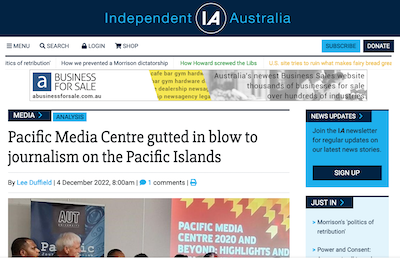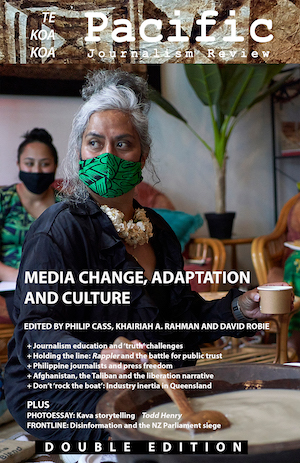SPECIAL REPORT: By Dr Lee Duffield
The launch of a New Zealand project to produce more Pacific news and provide a “voice for the voiceless” on the islands has highlighted the neglect of that field by Australia and New Zealand — and also problems in universities.
The new development is the non-government, non-university Asia Pacific Media Network (APMN), a research base and publishing platform.
Its opening followed the cleaning-out of a centre within the Auckland University of Technology (AUT) — in an exercise exemplifying the kind of micro infighting that goes on hardly glimpsed from outside the academic world.
- READ MORE: Media and academia: the intriguing case of the Pacific Media Centre — Media Asia
- Fate of a New Zealand research centre — university mischief, fears for free media — Sub-Tropic
- Future of AUT’s Pacific Media Centre under spotlight following director’s departure
- Pacific Media Centre must break free to survive
- Future of AUT’s Pacific Media Centre still up in the air
- Māori and Pacific academics at AUT concerned about impact of job cuts
- Other Pacific Media Centre reports
Cleaning out media centre
The story features an unannounced move by university staff to vacate the offices of an active journalism teaching and publishing base, the Pacific Media Centre, in early February 2021.
Seven weeks after the retirement of that centre’s foundation director, Professor David Robie, staff of AUT’s School of Communication Studies turned up and stripped it, taking out the archives and Pacific taonga — valued artifacts from across the region.
Staff still based there did not know of this move until later.
The centre had been in operation for 13 years — it was popular with Pasifika students, especially postgrads who would go on reporting ventures for practice-led research around the Pacific; it was a base for online news, for example prolific outlets including a regular Pacific Media Watch; it had international standing especially through the well-rated (“SCOPUS-listed”) academic journal Pacific Journalism Review; and it was a cultural hub, where guests might receive a sung greeting from the staff, Pacific-style, or see fascinating art works and craft.
Its uptake across the “Blue Continent” showed up gaps in mainstream media services and in Australia’s case famously the backlog in promoting economic and cultural ties.
The PMC Project — a short documentary about the centre by Alistar Kata in 2016. Video: Pacific Media Centre
Human rights and media freedom
The centre was founded in 2007, in a troubled era following a rogue military coup d’etat in Fiji, civil disturbances in Papua New Guinea, violent attacks on journalists in several parts, and endemic gender violence listed as a priority problem for the Pacific Islands Forum.
Through its publishing and conference activity it would take a stand on human rights and media freedom issues, social justice, economic and media domination from outside.
The actual physical evacuation was on the orders of the communications head of school at AUT, Dr Rosser Johnson, a recently appointed associate professor with a history of management service in several acting roles since 2005. He told the Australia Asia Pacific Media Initiative (AAPMI) in response to its formal complaint to AUT that it was “gutting” the centre that the university planned to keep a centre called the PMC and co-locate its offices with other centres — but that never happened.
His intervention caused predictable critical responses, as with this comment by a former New Zealand Herald editor-in-chief Dr Gavin Ellis, on dealing with corporatised universities, in “neo-liberal” times:
“For many years I thought universities were the ideal place to establish centres of investigative journalism excellence … My views have been shaken to the core by the Auckland University of Technology gutting the Pacific Media Centre.”
Conflicts over truth-telling
The “PMC affair” has stirred conflicts that should worry observers who place value on truth-finding and truth-telling in university research, preparation for the professions, and academic freedom.

The centre along with its counterpart at the University of Technology Sydney, called the Australian Centre for Independent Journalism (ACIJ), worked in the area of journalism as research, applying journalistic skills and methods, especially exercises in investigative journalism.
The ACIJ produced among many investigations, work on the reporting of climate policy and climate science, and the News of the World phone hacking scandal. It also was peremptorily shut-down, three years ahead of the PMC.
Both centres were placed in the journalism academic discipline, a “professional” and “teaching” discipline that traditionally draws in high achieving students interested in its practice-led approach.
All of which is decried by line academics in disciplines without professional linkages but a professional interest in the hierarchical arrangements and power relations within the confined space of their universities.
There the interest is in theoretical teaching and research outputs, often-enough called “Marxist”, “postmodern”, “communications” or “cultural studies”, angled at a de-legitimisation of “Western-liberal” mass media. Not that journalism education itself shies away from media criticism, as Dr Robie told Independent Australia:
“The Pacific Media Centre frequently challenged ‘ethnocentric journalistic practice’ and placed Māori, Pacific and indigenous and cultural diversity at the heart of the centre’s experiential knowledge and critical-thinking news narratives.”
Yet it can be seen how conflict may arise, especially where smaller journalism departments come under “takeover” pressure. It is a handy option for academic managers to subsume “journalism”, and get the staff positions that can be filled with non-journalists; the contribution the journalists may make to research earnings (through the Australian Excellence in Research process, or NZ Performance Based Research Fund), and especially government funding for student places.
There, better students likely to excel and complete their programmes can be induced to do more generalised courses with a specialist “journalism” label.
Any such conflict in the AUT case cannot be measured but must be at least lurking in the background.
The head of school, Dr Johnson, works in communication studies and cultural studies, with publications especially about info-advertising. He indicates just a lay interest in journalism listing three articles published in mass media since 2002.
What is ‘ideology’?
Another problem exists, where a centre like the former PMC will commit to defined values, even officially sanctioned ones like inclusivity and rejection of discrimination.
Undertakings like the PMC’s “Bearing Witness” projects, where students would deploy classic journalism techniques for investigations on a nuclear-free Pacific or climate change, can irritate conservative interests.
The derogatory expression for any connection with social movements is “ideological”. This time it is an unknown, but a School moving against an “ideological” unit, might get at least tacit support from higher-ups supposing that eviscerating it might help the institution’s “good name”.
What implications for future journalism, freedom and quality of media? Hostility towards specific professional education for journalism exists fairly widely. The rough-housing of the journalism centre at AUT is indicative, where efforts by the out-going director to organise succession after his retirement, five years in advance, received no response.
The position statement was changed to take away a requirement for actual Pacific media identity or expertise, and the job left vacant, in part a covid effect. The centre performed well on its key performance indicators, if small in size, which brought in limited research grants but good returns for academic publications:
“On 18 December 2020 – the day I officially retired – I wrote to the [then] Vice-Chancellor, Derek McCormack … expressing my concern about the future of the centre, saying the situation was “unconscionable and inexplicable”. I never received an acknowledgement or reply.”
Pacific futures
Journalism education has persisted through an adverse climate, where the number of journalists in mainstream media has declined, in New Zealand almost halved to 2061, (2006 – 2018). AUT celebrated 50 years of journalism teaching this week.
Also, AUT is currently in turmoil over the future of Māori and Pacific academics and the status of the university with an unpopular move to retrench 170 academic staff.

However new media are expanding, new demands exist for media competency across the exploding world “mediascape”, schools cultivating conscionable practices are providing an antidote to floods of bigotry and lies in social media.
The new NGO in Auckland, the APMN, has found a good base of support across the Pacific communities, limbering up for a future free of interference, outside of the former university base.
It will be bidding for a share of NZ government grants intended to assist public journalism, ethnic broadcasting and outreach to the region. While several products of the former centre have closed, the successful 28-year-old research journal Pacific Journalism Review has continued, producing two editions under its new management.
The operation is also keeping its production-side media strengths, such as with the online title Asia Pacific Report.
Independent Australia media editor Dr Lee Duffield is a former ABC correspondent and academic. He is a member of the editorial advisory board of Pacific Journalism Review. This article is republished with the author’s permission.
Pacific Media Centre gutted in blow to journalism on the Pacific Islands ~ Dr Lee Duffield https://t.co/lvLMm6lCmk @independentaus
— IndependentAustralia (@independentaus) December 3, 2022

